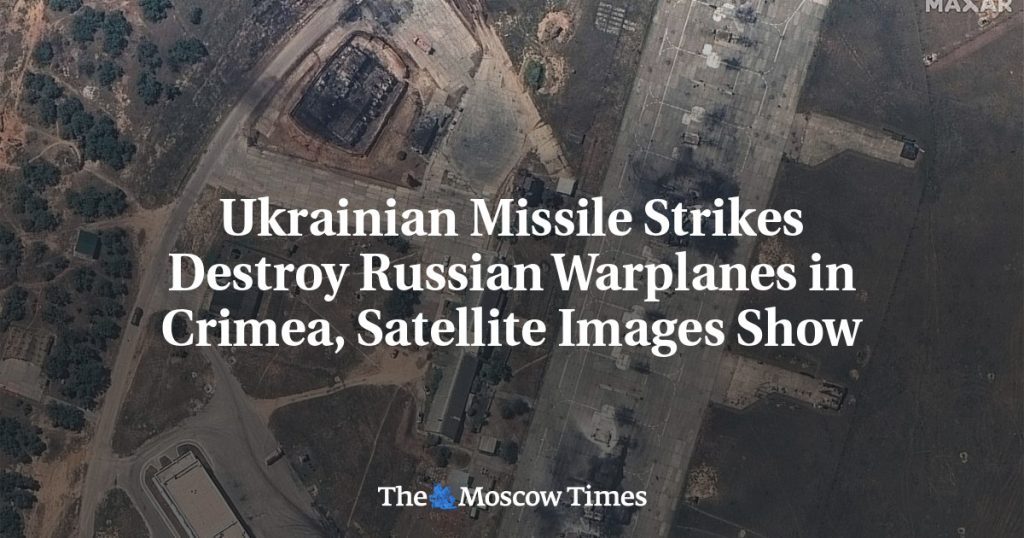Ukrainian missile strikes destroyed at least three Russian warplanes in Crimea this week, with satellite images confirming the damage. The Russian Defense Ministry claimed to have intercepted U.S.-supplied ATACMS missiles on Wednesday and Thursday. The Russian-installed governor of Sevastopol, Mikhail Razvozhayev, reported that Russian air defense systems had successfully shot down Ukrainian missiles over the Belbek airfield. Images from Maxar, a U.S. commercial satellite company, showed two destroyed MiG-31 fighter jets and one destroyed Su-27 fighter jet at the Belbek airfield, with one MiG-29 fighter aircraft also appearing damaged. The damages resulted from two consecutive Ukrainian strikes over two nights, as confirmed by satellite imagery from Planet Labs.
Sevastopol and Crimea, annexed by Russia in 2014, have been experiencing an increasing number of drone and missile strikes as Russian forces continue to make territorial gains on the frontline. The situation in the region has become more volatile, with ongoing tensions between Russia and Ukraine escalating into military confrontations. The attacks on Russian warplanes in Crimea indicate a more aggressive approach by Ukrainian forces in response to Russian actions. The conflict in the region has the potential to further escalate and draw in other countries, leading to a broader regional conflict with severe consequences.
The destruction of Russian warplanes in Crimea highlights the escalating conflict between Russia and Ukraine, with both sides engaging in military actions. The use of missiles and drones in the attacks indicates the advanced weaponry being utilized in the conflict, posing a significant threat to both military personnel and civilians in the region. The targeted strikes on Russian warplanes demonstrate Ukraine’s determination to defend its territory and push back against Russian aggression. The situation in Crimea remains tense, with both sides on high alert and prepared for further military confrontations.
The Russian Defense Ministry’s claim of intercepting U.S.-supplied missiles indicates the involvement of international actors in the conflict, with the U.S. indirectly supporting Ukraine in its fight against Russian forces. The use of advanced weaponry by both sides in the conflict raises concerns about the potential for further escalation and the impact on regional stability. The ongoing military actions in Crimea and Sevastopol underscore the volatile nature of the situation and the potential for a wider conflict involving other countries. The international community must closely monitor the developments in the region and work towards a peaceful resolution to the conflict.
The attacks on Russian warplanes in Crimea have led to increased tensions between Russia and Ukraine, with both sides accusing each other of provoking the conflict. The destruction of warplanes and military facilities in the region highlights the intensity of the ongoing confrontation and the risks of further escalation. The situation in Crimea and Sevastopol remains fluid, with the possibility of additional strikes and retaliatory actions by both sides. The international community must urge for a ceasefire and diplomatic negotiations to prevent a full-scale war in the region and avoid catastrophic consequences for the local population.
In light of the escalating conflict in Crimea, it is crucial for the international community to intervene and facilitate dialogue between Russia and Ukraine to prevent further escalation of the conflict. The attacks on Russian warplanes and military facilities demonstrate the urgent need for a peaceful resolution to the crisis in Crimea and Sevastopol. The use of advanced weaponry in the conflict poses a significant risk to regional stability and global security, underscoring the importance of diplomatic efforts to de-escalate the situation. The ongoing military actions in the region highlight the need for a diplomatic solution to prevent a wider conflict and ensure the safety and security of the people in Crimea and Sevastopol.


